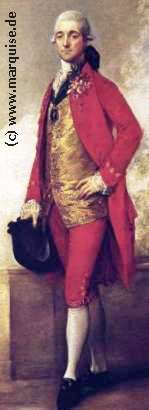| INDEX | 1300-1599 | 1600s | 1700s | 1800s | 1900s | CROSS-ERA | ETHNO | |
| MISCELLANY | CONTACT | SEARCH | |
|
|

Captain Wade by Gainsborough, 1771
The gilet has now become short and flaps open considerably at the bottom. In fact, the opening is incorporated into the pattern: The front edge angles outwards, just like that of the justaucorps. The waistcoat has all but lost its skirts, the front edge is curving away to the sides - we are approaching the shape of what would later become the tailcoat. Together with the smaller skirts, the cutaway front results in a somewhat more slender, smooth silhouette. All of this moved the front of the breeches into view, which may be the main reason why the buttoned centre front closure was replaced by a flap from about this time on.
Now the coat really couldn't be buttoned across the belly anymore; it was buttoned across the chest instead. The sleeve cuffs have diminished considerably in size. Although this coat has no collar, small standing collars have become more and more frequent by now. The cravat has developed from a soft cloth elegantly, casually wrapped around the neck to a relatively stiff, high band - the stock - with attached falling ruffles. It looks a bit like a standing collar and goes well with the new standing coat collars.
The new wig style is smooth around the forehead with only one or two rolls - ailes de pigeon - above each ear. At the back, there may be a bourse as well as a pigtail.
Of course Captain Wade, being a Brit, represents the British style that was to take the continent by storm during the followung two decades. His French contemporaries, while wearing clothes of largely the same cut, still indulged in lots of decoration (mainly embroidery) and wore wigs that rose high above the forehead.
| <<< PREVIOUS | NEXT >>> |
Content, layout and images of this page
and any sub-page of the domains marquise.de, contouche.de, lumieres.de, manteau.de and costumebase.org are copyright (c) 1997-2022 by Alexa Bender. All rights reserved. See Copyright Page. GDPO
This work is licensed under a Creative Commons License.